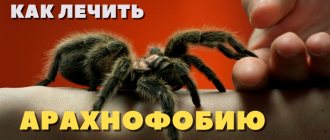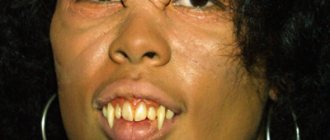- June 25, 2019
- Child's health
- Svetlana Funtova
For most people, a dog is a devoted friend and family member, but for others it is an object of potential threat. Ordinary fear can sometimes develop into panic and become a serious problem for a person’s psycho-emotional health. In this article we will look at what the phobia of fear of dogs is called, what signs it manifests itself, and what to do in this case.
What is the name of the phobia?
The word for fear of dogs comes from two Greek words, kuv (dog) and fobos (fear). Cynophobia is caused by an inexplicable and uncontrollable feeling of fear at the sight of an animal. This pathology is divided into two types:
- Adactophobia, that is, the fear of being bitten.
- Rabiephobia is the fear of contracting rabies.
Fear can manifest itself not only when being in close proximity to or in contact with a dog, but also when seeing images, watching videos or films involving animals. In the world, there are from one and a half to three and a half percent of people suffering from cynophobia. Most of them are children and young people under 30 years of age.
If you do not contact a specialist in a timely manner, the fear will intensify. Cynophobia is often observed in people suffering from schizophrenia, senestopathy, and hypochondria. The risk of getting sick increases with disorders of the central nervous system, neurosis, prolonged depression, and nervous tension.
Types of phobias
There are two types of fear of dogs: true and false.
The first appears during a real meeting with an animal. It, in turn, can take various forms: fear of exclusively large or small breeds, fear of a specific species, fear of meeting a stray pack of dogs, or a pathological fear of being bitten. True cynophobia is also considered a panicky fear of contracting rabies through contact with an infected animal. This form of pathology is characterized by an uncontrollable feeling of horror, stupor, panicky fear of the dog, and fear while being near the animal.
False phobia is a serious problem in society. As a rule, people with this disorder are overly aggressive towards the animal, regardless of its size, whether it is a domestic pet or a stray dog. They experience not so much fear as hatred. According to psychiatrists, a person disguises his sadistic inclinations behind false cinemaphobia. This form of psychological disorder manifests itself through the shooting of animals, their mass poisoning and other attempts to harm dogs. False kinophobes also pose a danger to pets due to their aggressive attitude towards any animal.
Conclusion
Dogs are not only pets, they are loyal friends, guards, helpers, and for some people, family members. Although most of them are trainable and do not pose a threat to others, they should be feared, and stray animals should be treated with extreme caution.
Being wary of dogs is a normal reaction, but in some people the fear is so strong and often groundless that it takes the form of a psychological disorder. If signs of cynophobia appear, it is recommended to consult a psychologist before the disorder becomes severe.
Distinctive features
Typically, people who are diagnosed with a phobia do not display aggressive behavior towards dogs, but rather avoid them. Those demonstrating false cinemaphobia are simply covering up their sadistic nature, carnage and psychopathy. If a person says: “I’m afraid of dogs,” here it is worth clearly distinguishing the true pathology from the pseudo disorder.
Also, cynophobes do not include people who neglect communication with dogs or ignore them for religious or personal reasons. To make a more accurate diagnosis, the following analysis is performed:
- a feeling of anxiety appears when seeing images of animals and other paraphernalia;
- a person tries by all means to avoid meeting a dog, not only realistically, but also hypothetically;
- other psychological diseases are identified;
- panic fear is primary, it is not a consequence of delusion or obsession.
Inna - psychologist
After the May post, a psychologist selection service contacted me, offered cooperation, and we agreed on three sessions at their expense with psychologist Inna Klimenko.
Three sessions, I want to continue.
deal with the panic fear of large dogs.
I don't have any positive experiences with dogs. There were no dogs in my environment (except for a couple of very small ones), but I had enough experience with homeless people. In the news they regularly bite or attack to death, and a couple of times they attacked me. Here are two situations:
1. Sunny day, spring. I go to English courses through the courtyards of five-story buildings. Suddenly there is a loud bark behind me, I turn around and a dog flies out at me. Everything inside breaks down, I run, but I remember that the right tactic is to stop and scare her. I stomped and screamed, which was a very scary thing to do in front of the angry dog’s face. This is what saved me.
2. Twilight, winter. I take a shortcut through a park in the center of Bucharest. Two large dogs emerge from the bushes. Hunched over, they slowly move towards me. There’s not a soul around, it’s dark, and I only see their furry silhouettes and sparkling eyes. I pull myself together, move backwards, no sudden movements. I leave and cry.
The two animals looked something like this - attentively and with preparation for battle. Or maybe my fear told me so. But I left the park with bricks Anna Yarkova
Formally, I wasn't bitten. But the strong fear was enough for me to shudder for the last 3 years at the sight of medium and large dogs, avoid them, but occasionally I could burst into tears.
It seems like you can live with this fear - everything is not so critical. But a month ago I came to visit new friends; they had a big mongrel at home, and I sat silently in the corner all evening, barely holding back hysterics. It's time to end this.
Symptoms
Kinophobia is accompanied by pronounced symptoms. When a person sees a dog, he experiences a lot of negative emotions, and sometimes even physical manifestations.
Symptoms of fear of dogs of large and small sizes include:
- uncontrollable irrational horror;
- a strong desire to hide and hide;
- difficulty breathing, inability to take a deep breath;
- noise in ears;
- feeling of chest tightness;
- trembling in hands.
As soon as the animal disappears from sight, the attack passes. With pathology that turns into a severe form, a person is constantly in tension, expecting at any moment to meet the object of fear. An neglected phobia very quickly turns into paranoia. It begins to seem to a person that animals always and everywhere follow him. To begin with, they purchase a dog repeller, eventually expanding their arsenal of protective equipment, since they feel uncomfortable without them.
If cynophobia is accompanied by another mental disorder, over time the fear turns into aggression, and the person becomes dangerous to society. Even if we exclude such serious consequences, when going outside, a kinophobes are in a state of stress, which inevitably leads to psycho-emotional exhaustion, restless sleep and neuroses.
Causes of phobia
Why do people have a fear of dogs? This type of disease takes a long time to develop. In adults, the disorder occurs against the background of other mental disorders and suppressed fears. In fact, there are very few objective reasons for cinemaphobia. Psychologists say that the basis of the disease is fear. It evokes an undeniable belief that the animal will certainly attack, bite or even kill.
There are cases when a person, having survived a dog attack, begins to fear only a certain breed or exclusively large dogs, without reacting to small puppies. The phobia manifested in this way in adults allows one to partially overcome attacks of fear.
The most common causes of cynophobia include:
- genetic predisposition;
- instilling a feeling of fear by parents;
- diffidence.
Education is of great importance in the formation of personality. If you instill in your child that dogs are a great danger, he will not be able to ignore them. The words of parents, embedded in the subconscious, will cause a feeling of fear. People with an inferiority complex find it difficult to get settled in life; they feel that they are not smart enough, beautiful enough, and are afraid of everything that surrounds them, dogs, people.
Causes of the disorder
In most cases, fear of cynophobia develops in a person in childhood and is associated with the characteristics of his upbringing.
The main causes of cynophobia:
- Stories from relatives and friends about dog attacks, showing scars left after bites.
- Emotional, negative reaction of parents to the approach of a dog to a child.
- Kinophobia in children develops if their parents frighten them with bites or rabies.
We recommend that you read: Fear of spiders - what is the name of the phobia and how to stop being afraid of them
If the parents demonstrated their dislike and hatred towards dogs, the child adopts this model of behavior as the only correct one, which leads to the development of a phobic disorder in the future.
How does cynophobia manifest itself?
Fear of dogs manifests itself in different ways; most often, at the sight of an animal, a person experiences panic, changes his route and tries to escape as quickly as possible. The irrationality of such behavior largely depends on the form of pathology. Sometimes, seeing a small dog, an adult climbs a tree in fear.
Autonomic manifestations of cynophobia include:
- tachycardia;
- shiver;
- cardiopalmus;
- decreased or increased blood pressure;
- pale skin;
- increased sweating;
- feeling of chest compression;
- labored breathing;
- dry mouth.
Mental manifestations include:
- irritability;
- mental replay of unpleasant events associated with the dog;
- nightmares;
- panic attack.
What does an neglected phobia lead to?
To avoid encountering dogs, the patient changes his route to work, even if it is much longer. The patient goes to another store, changes his hobbies and interests in such a way that the chance of meeting a dog is minimal. If dogs walk near the house, then the cynophobe does not go outside until the animals leave. In advanced stages, the patient locks himself at home, orders food to be taken home, and finds remote work. If someone he knows has dogs, he stops communicating with these people.
Can a dog sense human fear?
According to popular belief, large and small dogs sense the fear of a person, who, when they see a potential danger, tries with all their might to overcome it. This occurs due to the release of adrenaline into the blood. In fact, the hormone cannot activate the receptors responsible for aggression, which has been proven more than once in special studies.
The animal reacts not so much to fear as to human behavior. The latter shows his feelings and tension through gestures, facial expressions, shouting or active actions. Therefore, in such cases, you mainly need to deal with emotions, and not think about the release of adrenaline.
How to behave in the event of danger
To get rid of fear at the sight of dogs, you should first familiarize yourself with the rules of conduct when near an aggressive animal. They are:
- The dog should not be provoked by looking eye to eye.
- You should remain calm, do not make sudden movements and do not run.
- It is important to control facial expressions; a smile or grin can be associated with showing teeth, and therefore serve as a challenge.
- If you carefully throw an object away, the dog can switch its attention to it.
- If the dog starts to attack, you can neutralize it with a blow to the nose.
If a child is afraid of dogs: advice for parents
- Don't scold him or shame him. This way you will only push the problem inside and deprive the child of your protection and support.
- Teach your child to speak out his fear. Remember: everything named becomes less scary.
- Tell your child about your fears: let him see that he is not alone.
- Make physical contact with your child if a dog comes into view. When mom holds your hand, fear recedes!
- When walking with your child, on occasion, draw his attention to the positive aspects of dogs: how they play with their owner, how they follow commands, how funny, smart, and kind they are!
- Try watching a movie or cartoon with your child where the main character is a dog. Discuss her qualities (courage, loyalty, devotion).
- Gradually reduce the distance between your child and dogs. If at first you walked the dogs for a kilometer, then let it be 50 m, then 10 m, then 5 m.
- Have patience. Do not expect that your child will heed your arguments and stop being afraid of dogs as soon as you explain to him that there is no need to be afraid of dogs. Everything takes time.
- Show calm confidence that dogs generally pose no danger. Let your child see you petting a friendly dog on the street and how it sniffs you.
- The final point in your work to eliminate your child’s fear of dogs will be his willingness to pet the dog. Let it be with you, hand in hand, let it be from behind your back and under your protection. If the child takes this step, it means that cinemaphobia has receded!
Remember: we all change as we go through life. Even if yesterday the baby was afraid of dogs... Tomorrow a dog can become his most faithful friend!
Ways to get rid of a phobia
You can get rid of cynophobia with the help of:
- hypnosis;
- drug treatment;
- sessions with a psychologist.
Therapy may require a significant investment of time. This mainly depends on the severity of the pathology, the desire and efforts of the patient, and the form of psychological disorder.
Antidepressants or potent tranquilizers are usually prescribed as medications. It is worth noting that such medications have a number of side effects and are addictive, so treatment should be carried out strictly under the supervision of a specialist. Among all patients diagnosed with cynophobia, only 10% need the help of a qualified psychotherapist. However, it would not hurt to include a visit to the doctor in a set of measures to get rid of fear.
Treatment can occur as follows:
- Viewing pictures of the animal, during which the patient shares his emotions.
- By way of transformation. When contacting a dog, you need to mentally imagine yourself as an object that does not arouse interest in the dog.
- Working through positive factors. During them, they watch films with kind dogs and read specially selected literature.
- Contact with a puppy, which causes exceptional affection and is absolutely harmless.
Independent control measures
You can try to cope with this problem yourself. To do this, you should take the following steps:
- Poor nutrition leads to disorders of the central nervous system, which are expressed by increased anxiety. A balanced diet serves as a prevention, including psychological problems.
- You should normalize your daily routine, rest more and spend more time in the fresh air. Mental fatigue is no less dangerous for psychological health.
- Sports activities improve the functioning of the central nervous system, improve mood and self-esteem.
- Find something you like that will calm you down, put you in a positive mood and distract you from bad thoughts.
- Work on your own self-knowledge, overcoming all existing fears and self-doubt.
Kinophobia in a child
Very often, children tend to be afraid of things that seem unimportant to adults. This also applies to fear of dogs. If a phobia does not go away, it may progress over time and become a serious problem.
When communicating with a child, you cannot ridicule or belittle his fears. Attempts to force a pet to pet or play with a pet, or imposing communication can only aggravate the situation. Children's fear of dogs will not disappear, but mistrust and condemnation of their loved ones will appear.
The best option would be professional help from a psychologist-hypnologist who will help you quickly and effectively solve the problem. The child will be able to overcome fear gradually, in a gentle way, in a playful way and through art therapy.
If your child does not have a panicky fear at the sight of dogs, you can suggest that he get a small puppy. Growing up and spending time together will allow you to overcome the problem naturally. However, it is worth remembering that the child must agree with the purchase of the pet, no surprises.
What absolutely should not be done
There are many ways to raise a hysterical, cowardly and potentially dangerous dog. In addition to outright cruelty and boundless indifference, the following can lead to this:
- Shouting, insults and physical abuse in various situations. It doesn’t matter whether the pet misbehaved, didn’t follow a command, or the owner is simply in a bad mood. You cannot take out anger and irritation on an animal, and screaming has never been the right method of education.
- Limiting your pet's communication with other animals. If isolated, the dog will perceive both a huge St. Bernard and a tiny duckling as a threat. The result is a desperate coward with a shattered nervous system.
- Lack of training and regular walks. The dog must receive new information. In addition, it is natural for her to relieve herself in nature, and not in a tray or on a diaper. Isolation has never made anyone brave.
- Prohibition for pets to communicate with pets. In this case, he will perceive everyone as strangers. Of course, dogs of guard breeds should not fawn over strangers on the street, but friendliness will not harm decorative dogs at all. In addition, they will not perceive people as a threat.
- Reluctance to visit a veterinary clinic and grooming salon. This is also a type of communication when a dog finds itself in an extreme situation. Soon she gets used to it and is no longer afraid. For her, a visit to the doctor or a wash, haircut, or nail trimming cease to be stress triggers, so they do not provoke the appearance of fear. If the dog is completely unprepared for such a situation, then his reaction can be unpredictable, which will have a bad effect on the state of the nervous system.
To adapt an animal to everyday life, you need to communicate with it, and not shake it like a porcelain doll. Such treatment can do him a disservice.











